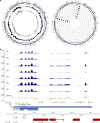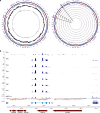A spliced latency-associated VZV transcript maps antisense to the viral transactivator gene 61
- PMID: 29563516
- PMCID: PMC5862956
- DOI: 10.1038/s41467-018-03569-2
A spliced latency-associated VZV transcript maps antisense to the viral transactivator gene 61
Abstract
Varicella-zoster virus (VZV), an alphaherpesvirus, establishes lifelong latent infection in the neurons of >90% humans worldwide, reactivating in one-third to cause shingles, debilitating pain and stroke. How VZV maintains latency remains unclear. Here, using ultra-deep virus-enriched RNA sequencing of latently infected human trigeminal ganglia (TG), we demonstrate the consistent expression of a spliced VZV mRNA, antisense to VZV open reading frame 61 (ORF61). The spliced VZV latency-associated transcript (VLT) is expressed in human TG neurons and encodes a protein with late kinetics in productively infected cells in vitro and in shingles skin lesions. Whereas multiple alternatively spliced VLT isoforms (VLTly) are expressed during lytic infection, a single unique VLT isoform, which specifically suppresses ORF61 gene expression in co-transfected cells, predominates in latently VZV-infected human TG. The discovery of VLT links VZV with the other better characterized human and animal neurotropic alphaherpesviruses and provides insights into VZV latency.
Conflict of interest statement
The authors declare no competing interests.
Figures






Similar articles
-
Varicella-zoster virus VLT-ORF63 fusion transcript induces broad viral gene expression during reactivation from neuronal latency.Nat Commun. 2020 Dec 10;11(1):6324. doi: 10.1038/s41467-020-20031-4. Nat Commun. 2020. PMID: 33303747 Free PMC article.
-
Varicella-Zoster Virus (VZV) Small Noncoding RNAs Antisense to the VZV Latency-Encoded Transcript VLT Enhance Viral Replication.J Virol. 2020 Jun 16;94(13):e00123-20. doi: 10.1128/JVI.00123-20. Print 2020 Jun 16. J Virol. 2020. PMID: 32295909 Free PMC article.
-
Decoding the Architecture of the Varicella-Zoster Virus Transcriptome.mBio. 2020 Oct 6;11(5):e01568-20. doi: 10.1128/mBio.01568-20. mBio. 2020. PMID: 33024035 Free PMC article.
-
Recent Issues in Varicella-Zoster Virus Latency.Viruses. 2021 Oct 7;13(10):2018. doi: 10.3390/v13102018. Viruses. 2021. PMID: 34696448 Free PMC article. Review.
-
Varicella-zoster virus human ganglionic latency: a current summary.J Neurovirol. 2010 Nov;16(6):411-8. doi: 10.1007/BF03210846. Epub 2010 Sep 27. J Neurovirol. 2010. PMID: 20874010 Review.
Cited by
-
Exploring the Seasonal Drivers of Varicella Zoster Virus Transmission and Reactivation.Am J Epidemiol. 2021 Sep 1;190(9):1814-1820. doi: 10.1093/aje/kwab073. Am J Epidemiol. 2021. PMID: 33733653 Free PMC article.
-
No evidence of aberrant amyloid β and phosphorylated tau expression in herpes simplex virus-infected neurons of the trigeminal ganglia and brain.Brain Pathol. 2022 Jul;32(4):e13044. doi: 10.1111/bpa.13044. Epub 2021 Dec 16. Brain Pathol. 2022. PMID: 34913212 Free PMC article.
-
Varicella-Zoster Virus-Genetics, Molecular Evolution and Recombination.Curr Top Microbiol Immunol. 2023;438:1-23. doi: 10.1007/82_2021_238. Curr Top Microbiol Immunol. 2023. PMID: 34374828
-
Antisense Transcripts and Antisense Protein: A New Perspective on Human Immunodeficiency Virus Type 1.Front Microbiol. 2021 Jan 12;11:625941. doi: 10.3389/fmicb.2020.625941. eCollection 2020. Front Microbiol. 2021. PMID: 33510738 Free PMC article. Review.
-
Analysis of Virus and Host Proteomes During Productive HSV-1 and VZV Infection in Human Epithelial Cells.Front Microbiol. 2020 May 29;11:1179. doi: 10.3389/fmicb.2020.01179. eCollection 2020. Front Microbiol. 2020. PMID: 32547533 Free PMC article.
References
Publication types
MeSH terms
Substances
Grants and funding
LinkOut - more resources
Full Text Sources
Other Literature Sources
Medical
Miscellaneous

